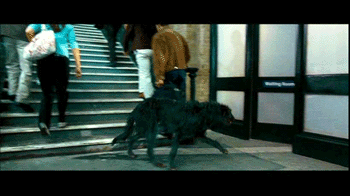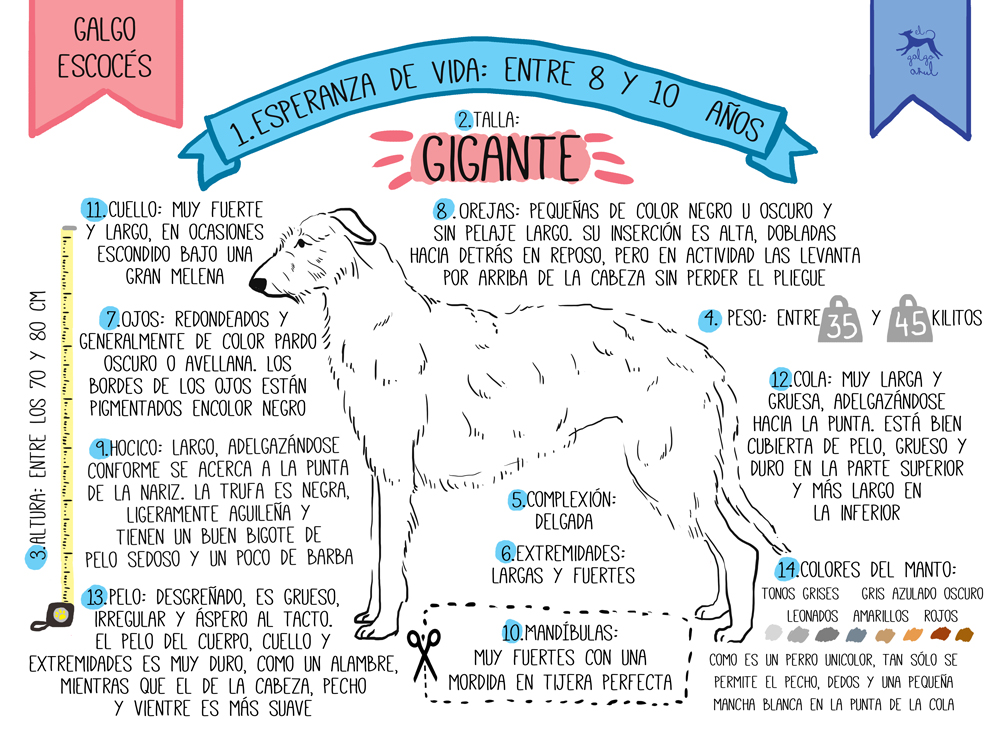In the Scottish Highlands a dog with an intense gaze and a rebellious soul emerged that earned the title of Royal Dog of Scotland. The Scottish Greyhound was a large hunting dog that suffered with the arrival of the changes of the Contemporary Age, but that earned its survival thanks to the fans who made it a national symbol of Scotland.
Unknown to many, the Deerhound is a mysterious dog of robust beauty and a big heart. These charms bewitched JK Rowling, who used an enigmatic Deerhound to embody Canute, the canine version of Sirius Black, in the third installment of the film saga of Harry Potter.



ORIGIN AND HISTORY OF THE SCOTTISH LEBREL
The history of the Scottish hound shares the same beginning as that of the greyhound, since both were developed in Great Britain. The origin of this family of English sighthounds is located in the Middle East, being the Phoenicians responsible for having introduced the Egyptian sighthounds in Europe around the 10th century BCE. How it came to the British Isles is already more difficult to define, as there is no historical record.
One of the main theories about the arrival of their ancestors to the Islands points to Celts, who carried the greyhound from the mainland to Great Britain and Ireland during their territorial expansion in the 4th century BCE. Be that as it may, upon arrival in the Islands they were crossed with other breeds existing in the territory, like shepherds and molossi.
With the passing of the centuries, differentiated racial lines were developed according to their geographical location and purpose. There are historical references from the 15th century of the different lines then called as rough or wire haired Greyhound, Irish Greyhound, English Greyhound, Scotch Greyhound, Scottish Deerhound Y Highland Deerhound. All of them were defining themselves as distinct races, but they still shared great similarities. In the case of the Scottish Greyhound, there was a lot of variety, but it can be defined two distinct lines: the Scottish Highland greyhound and the one from the Lowlands, the first being bigger, stronger and with a thicker coat than the second.
The Scottish Greyhound was used to hunt large game, mostly deer, hence its name in English Deerhound. He became a large dog, with a lot of power and physical strength to be able to play alone, or together with another partner, the whole process of hunting: from deer tracking and location to hunting and dragging to humans.
Its characteristics made it a very valuable dog and exclusive possession which earned the title of «Royal Dog of Scotland«, But, for that same reason, it came to harm their survival in history. In the 18th and 19th centuries the Deerhound suffered its most critical moment and was on the brink of extinction.
The first blow came after the destruction of the Scottish clan system at the Battle of Culloden, while the second was with the advent of firearms and the partition of the Scottish estates in smaller spaces for cultivation and livestock, which harmed the deer population due to the destruction of the forests.
The hunting system changed and it was no longer necessary for a dog to be able to carry out the entire process on its own. With the new firearms, the humans began to stalk the animal themselves to shoot it when it was within range. The wounded animal fled and they made use of a dog with better tracker skills and smaller dimensions than the Deerhound, such as a Collie, to follow the injured animal and locate it for the human.
Despite these difficulties, fans like Archibald and Duncan McNeill they achieved the recovery of the Deerhound. Thanks to the work of fans during the 19th century, the Scottish Greyhound survived and was also able to help the recovery of its sister breed the Irish Greyhound. Also, the arrival of dog shows helping at establish a breed canon, which became the goal to follow among fans.
With the arrival of the First World War the breed suffered another setback. The great estates that still existed in Britain were divided and the Deerhound became a rarity only enjoyed by a few. Despite this, its low popularity has guaranteed it a quality breeding on the part of the passionate of the race, avoiding its degeneration and that your standard has arrived intact to this day
At present, Scottish sighthounds have left behind their original purpose of hunting large game and they have become a great companion dog thanks to its sweetness. A great dog with a lot of history who has earned himself to be one of the undisputed symbols of Scottish culture.
PHYSICAL CHARACTERISTICS OF THE SCOTTISH LEBREL
The official standard for the Scottish Greyhound was established by the International Cynological Federation in 2012. Classified in group 10 section 2 as wire-haired sighthounds, their physical characteristics are:


- Hope of lifetime: between 8 and 10 years.
- Size: giant.
- Height: between 70 and 80 cm.
- Weight: between 35 and 45 kg.
- Complexion: slim.
- Extremities: long and strong.
- Eyes: rounded and generally dark brown or hazelnut in color. The edges of the eyes are pigmented black.
- Ears: small, black or dark in color and without long fur. Its insertion is high, bent backwards at rest, but in activity it raises them above the head without losing the fold.
- Snout: long, tapering as it approaches the tip of the nose. The nose is black, slightly aquiline and they have a fine mustache with silky hair and a little beard.
- Jaws: very strong with a perfect scissor bite.
- Neck: very strong and long, sometimes hidden under a large mane.
- Line: very long and thick, tapering towards the tip. It is well covered with fur, thick and hard at the top and longer at the bottom.
- HairShaggy, thick, uneven and rough to the touch. The hair on the body, neck and extremities is very hard, like wire, while that on the head, chest and belly is softer.
- Coat colors: gray - dark bluish, gray tones (light and dark), tawny and yellow, sand red or fire red with black mask, eyes, limbs and tail. As it is a unicolor dog, only the chest, fingers and a small white spot on the tip of the tail are allowed.
Despite the physical similarities it may share with greyhounds, deerhounds were genetically selected to hunt large game such as deer, so They are giant dogs with great physical power. Her fur, although disheveled in appearance, protects you against low temperatures and they do not make him a friend of the warm regions.
CHARACTER OF THE SCOTTISH LEBREL
Scottish Greyhound It is a dog that imposes due to its bearing and intense gaze, but, behind that rough appearance, there is a greyhound extremely affectionate and close, less shy than its sister breeds who enjoys human company.
They are very obedient dogs and solicitous, so they are very easy to teach. Still, we must bear in mind that they are very sensitive just like the other greyhound breeds, so we must opt for a polite or positive education. In this education model, active punishments and the use of fear are dispensed with, avoiding serious problems such as learned helplessness in the future.
The deerhound It is a greyhound bred to hunt large game, so it has a natural predisposition towards hunting for prey on the move. Its large size does not reduce its agility or momentum to start the race and its physical strength allows it to drop and drag large pieces without problem. As it is a predominantly visual breed, we must pay close attention to the environment if we release it in unbounded spaces.
Despite his genetic selection and courageous character, It is not a suitable dog for guarding and does not require great physical exercise. The Scottish Greyhound is a very calm dog that needs moderate exercise and loves to rest for much of the day.
SCOTTISH LEBREL DISEASES
The Scottish Greyhound can be affected by a series of pathologies more frequent in their racial group:
- Heart diseases.
- Factor VII deficiency.
- Hip dysplasia.
- Gastric torsion.
- Gastric dilation.
- Osteosarcoma.
- Chemical sensitivity to certain compounds and medical treatments, such as anesthesia.
CARE OF THE SCOTTISH LEBREL
Scottish Greyhound It does not require much care, just pay a little attention to your hair. Despite being hirsute, your hair should be brushed regularly to keep it healthy and remove dead hair in shedding times. After walks through wild areas, it is very important that you let's check the mantle well to detect possible parasites like fleas and ticks.
Despite not having woolly hair, it is a breed that is friendly to cold climates, so it is necessary to provide cooler rest areas when temperatures rise. Hair should never be cut or shaved during the summer because it serves as a thermal insulator and protects you from the sun.
We must avoid resting on the ground or hard surfaces when looking to cool down because it is a breed prone to corns and joint sores.
As with other dogs, it must visit the vet regularly for your vaccination, deworming and health checks. You should also maintain a stable routine of daily walks and feeding.
YOU AND YOUR SCOTTISH LEBREL
Are you one of the lucky ones who shares your couch with a Scottish Greyhound? Well, don't wait any longer to share your experience with us. Go ahead and leave us a comment telling us your story. We can't wait to meet her!








